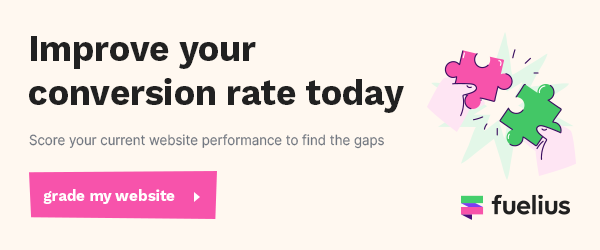
- Hello reader
- Your website is not responsive
- High bounce rate
- Your website doesn't align with your current branding
- Loading takes forever
- Your site autoplay
- It just looks outdated
- Your search engine rankings are low
- Poor conversion rates
- You're embarrassed to send people to your website
Marketers are an intuitive bunch, so if your gut is telling you that you need one, you probably do. So that kicks off our list –
1: Hello reader!
For the remaining nine points, we’re going to list some of the common red flags which, if you spot them, should give you an inkling that it’s time to bite the bullet and get a new site for your business.
2: Your website is not responsive
Though this list isn't in any particular order, this one is pretty important. If your website isn't responsive yet then stop what you're doing – and start planning your new site.
A responsive site will change how it displays depending on the size of the screen, so mobile or tablet users should get a version of your site that is easier to navigate and use.
If your site isn't responsive you're not only damaging your user's on-site experience if they're visiting on a mobile device, you're, without a doubt, reducing the number of visits to your site.
85% of adults think that a company’s website when viewed on a mobile device should be as good or better than its desktop website.
Google's ranking algorithm takes into account whether your site is responsive. If it isn't, the search engine will score you as a poor content provider and will penalise your site with a reduction in search authority.
If you're unsure if your website is mobile-friendly or not, then you'll be glad to know that Google will also help you out. You can use Google's Mobile-Friendly Test.
3: High bounce rate
.gif?width=320&height=180&name=ezgif.com-gif-maker%20(15).gif)
Source: GIPHY
Firstly, let’s address the elephant in the room – Google’s official definition of a ‘bounce’ is a single-page session on your site. Basically, someone has hit your landing page and then left without exploring deeper into your site.
If you've got a high bounce rate, that means that most likely you have confusing design or content, upfront requests for too much personal info or simply ugly pages.
This isn't an exhaustive list of reasons, however, these are some common ones to look out for. New websites can also fall foul of a high bounce rate, however, it is harder to remedy on an older site with many pages and legacy issues.
To help reduce your bounce rate you need a clean design, good functionality and the ability to post relevant sticky content that interests people in a way that takes into account modern consumer habits and mobile. To manage all of this, it’s easier to look at launching a new site.
4: Your website doesn't align with your current branding
Now, more than ever, your website and branding need to align, or you could look at it this way – your branding and website need to match.
For most businesses now, your website is your primary marketing tool – your shop window – so it needs to be consistent. You don’t expect to walk past a Mcdonald's and see posters of burgers named King and Whopper – it’s inconsistent and it would make you suspicious.
It’s the same with your website. If you have brand guidelines for colours, fonts, image use, image style etc., stick to them. If not, write some and stick to them. Brand guidelines can be tricky to implement into an existing environment, but building them alongside a new website means from day one they become the standard.
5: Loading takes forever
This one is similar to the point we made about your website is responsive – and it goes beyond a user's on-site experience. Google will penalise your site if your page speed is low – the lower the page speed, the more severe the penalty. Though it's kinda crazy, 47% of users expect a maximum of 2 seconds loading time for an average website.
Again, if this is something you've never thought about before, then you might not even have an indication of how fast your site is. Google has another handy tool that you can use: take a look at Google's PageSpeed Tools here.
6: Your site autoplay
Say the words 'auto-playing', and 'audio' to any UX expert and they'll point you towards the exit (and tell you how to get there in the fewest amount of steps).
If you've still got auto-playing audio on your website, the chances are you have a real problem you’re unaware of. Autoplay kills your page load speeds (see previous) and puts users off exploring further. In fact, it doesn’t just drive them away, it drops the barrier and tells them not to come back.
If this is integral to your website, it’s definitely time to look at a refresh.
7: It just looks outdated
There's no getting away from the fact that one of the biggest indicators that you need a new site is that it just looks 'old'.
Are you comfortable with your site? Do you think everyone recognises it? No? Then it’s time to get a new one. Comfort is not the goal. Your authority and trust on the web come not from comfort, but from content. If your site looks like something from the 90s, no one's going to read your content because they’ll assume it's also from the 90s.
Why would they be interested in the content of a site that predates Facebook, Twitter, broadband, and smartphones? If you've become comfortable with your website design, it’s time to change.
8: Your search engine rankings are low
The truth is, some older sites haven't had much work done on their keyword strategy, carry a lot of duplicate pages and content and are riddled with problems that make life difficult for Google and other search engines to index and evaluate them. And when something makes life difficult for a search engine, it simply moves on, penalising you in the process.
By deciding to go for a new website, you have the opportunity to clean up all that SEO muck and start climbing back up the rankings.
9: Poor conversion rates
You might think your website is performing well if you've got a steady stream of traffic. But the metric you really need to look at is conversion. A load of traffic means your website is doing some elements right, however, if you're not seeing that traffic transition into leads, the conversion pathways on your website might not be up to scratch.
Elements like your navigation, CTAs, forms, internal links etc., may not be performing as well as they should be in guiding your audience towards your intended actions. Tools like HotJar can help you understand what might be blocking conversion through visual heatmaps and feedback surveys.
10: You're embarrassed to send people to your website
If you're embarrassed to send people to your website the chances are that this is because you know that the site doesn't reflect your ability as a marketer or the calibre of the brand the site serves. You should be proud to give out your URL to your peers – many people are.
Get an instant website audit report
If you want to know exactly where your specific website is going wrong, our free website grader tool can help. Simply plug in your website URL and wait a few moments before it provides you with a comprehensive breakdown of key performance areas like SEO, responsiveness and security.
You'll also get scored across each of these areas so that you're able to actively monitor any changes you make going forward. Most websites only score 60 out of 100! It also provides insights into how you can fix these components, or you can request a meeting with one of our website specialists who can go into more detail about areas for improvement.





